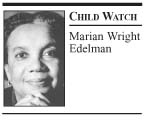 The National Urban League recently released its annual report on the status of Black Americans. The report features the "Equality Index," a statistical measurement of disparities or "equality gaps" between Blacks and Whites across five key areas. The index gives a unique picture of how Black America is doing, and it shows how far we still have to go.
The National Urban League recently released its annual report on the status of Black Americans. The report features the "Equality Index," a statistical measurement of disparities or "equality gaps" between Blacks and Whites across five key areas. The index gives a unique picture of how Black America is doing, and it shows how far we still have to go.
This year's Equality Index measured the gaps between Blacks and Whites in economics, health, education, social justice and civic engagement. Whites were given a value of one in each category, and Blacks were measured against their performance. A score higher than one meant Blacks were doing better than Whites, and a score less than one meant Blacks were doing worse.
Overall, the Equality Index showed Blacks are at 0.73 of the status of Whites. On most report cards, that's a C. The National Urban League report makes another comparison: It points outs that "Article I, Section 2 of the U.S. Constitution counted an enslaved African American for tax and state representation purposes as three-fifths of person, or 60 percent (0.60) index value." So from slavery to 2006, we haven't made it all that far.
Where exactly do we still fall short? The biggest gap is in economic equality. The report found the median net worth of the average Black family is 10 times less than the average White family — $6,166 versus $67,000, mainly because of the differences in both income levels and homeownership rates. Median income levels for Blacks were significantly lower than those for Whites, and unemployment rates were twice as high. Meanwhile, homes remain a key source of net worth and wealth, but just under half of Blacks own their homes, compared to 70 percent of Whites.
The persistent Black-White health gap is another key concern, especially since the National Urban League has identified some discouraging trends, including increases in the proportions of Black children and adults without health insurance. As the study points out, "Take a group that suffers disproportionately from health care issues, and couple that with a higher percentage of that group not having the means to combat illness or receive preventative treatment — the outcome is a vicious cycle that holds the promise of perpetuating itself for years to come."
This year's report is especially ironic in the wake of last year's hurricanes: "Hurricanes Katrina and Rita and the tragically slow government response exposed, in the starkest and most depressing terms imaginable, the race and class gaps that our previous reports and Equality Indexes had highlighted. Sadly, these numbers were illustrated in sharp relief last summer when America was forced to see the gaping chasm between White and Black America, the haves and the have-nots."
So what can we do about the persistent inequality? There are specific solutions, including fighting racial discrimination in housing and mortgage lending; increasing economic literacy and information about access to credit; strengthening anti-discrimination laws; and eliminating further tax cuts for the wealthiest Americans.
Answers are out there. We don't have to be three-fifths or three-fourths of full Americans forever.
Marian Wright Edelman is founder and president of the Children's Defense Fund.


















































































































































































































































































































